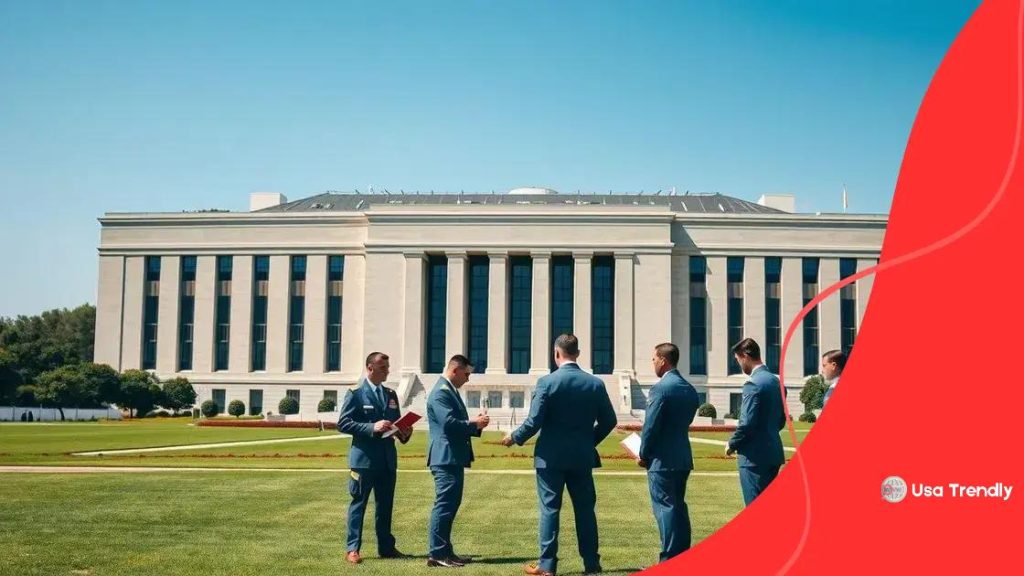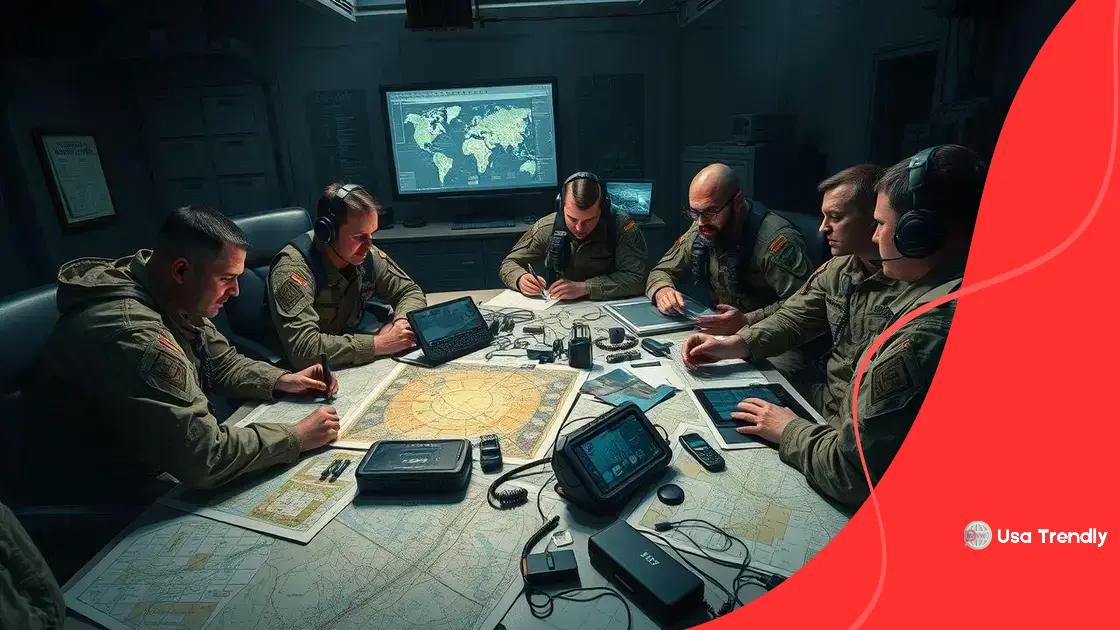Pentagon to reduce number of top generals amid budget cuts

The Pentagon’s decision to reduce the number of top generals aims to enhance military efficiency, streamline decision-making, and adapt to modern warfare, while also facing challenges related to leadership gaps and cultural shifts.
Pentagon to reduce number of top generals is making waves as the military reevaluates its command structure. What does this mean for operational efficiency and leadership?
Overview of the Pentagon’s restructuring plans
The Pentagon’s restructuring plans are a significant move towards improving military efficiency. As budgets tighten, the need to reassess the command structure becomes essential. This initiative aims not only to streamline operations but also to adapt to modern warfare demands.
Key Objectives of the Restructuring
The main goals include enhancing performance and minimizing unnecessary overhead. These adjustments will enable the military to focus on more critical areas, ensuring that every resource is utilized effectively. Some of the key objectives involve:
- Reducing the number of senior military positions.
- Aligning resources with current global threats.
- Improving overall command efficiency.
The Pentagon is also exploring the digital transformation of its operations. This includes the integration of advanced technologies to support decision-making processes. In a fast-evolving combat environment, having real-time data is crucial for success. By reorganizing the command structure, they hope to foster a culture of agility and responsiveness.
Expected Changes in Leadership Roles
With fewer top generals, the landscape of military leadership is bound to change. Newly defined roles will likely emphasize collaboration and coordination among teams. The goal will be to cultivate a more interconnected military environment to tackle complex challenges.
Moreover, this shift may open doors for younger leaders to rise through the ranks faster. By promoting efficiency and meritocracy, the Pentagon hopes to inspire a new generation of military professionals who can adapt to the changing dynamics of modern warfare.
Reasons behind the decision to reduce generals
The decision to reduce the number of generals in the Pentagon is driven by various factors aimed at enhancing military effectiveness. As budgets continue to tighten, it has become necessary to reassess command structures to ensure they are both efficient and responsive to current needs.
Financial Constraints
One major reason for this decision lies in financial constraints. The Pentagon faces pressure to allocate funds more effectively. Fewer high-ranking positions may lead to significant savings in personnel costs.
- Reducing salaries and benefits for senior staff.
- Redirecting funds to essential military programs.
- Allowing for reinvestment in technology and better resources.
Moreover, the complex global landscape calls for a more agile military response. The current security environment is volatile, highlighting the need for flexibility. Fewer generals might mean faster decision-making and improved coordination during crises.
Modern Warfare Adaptation
The evolution of modern warfare also plays a critical role in this restructuring. Traditional hierarchical structures may not apply effectively in today’s fast-paced combat situations. This change underscores the importance of adapting military leadership to meet new challenges.
New strategies, such as cyber warfare and autonomous systems, require leaders who embrace innovation over traditional command styles. By reducing the number of generals, the Pentagon can streamline its leadership structure, encouraging a culture of collaboration and rapid response.
Impact on military operations and effectiveness

The impact on military operations and effectiveness due to the Pentagon’s decision to reduce generals is significant. With fewer leaders in place, the military aims to operate more efficiently while adapting to modern challenges.
Streamlined Decision-Making
One of the most important changes is the potential for streamlined decision-making. A reduction in the number of generals can lead to quicker and more decisive actions on the battlefield. When fewer people are involved in the decision process, there is less chance for delay and confusion, which is crucial in high-pressure situations.
- Enhanced communication channels among forces.
- Faster approval of military strategies.
- Increased flexibility to adapt to emerging threats.
Additionally, the shift encourages a more agile command structure that can swiftly respond to unexpected circumstances. In the modern landscape of warfare, where threats can evolve rapidly, having leaders who can adapt at a moment’s notice is vital for maintaining operational effectiveness.
Focus on Collaboration
The reduction also promotes collaboration among different military branches. With fewer senior officers, there is an opportunity for teams to work more closely. This promotes a unified approach, allowing the military to leverage diverse skills and capabilities effectively.
A collaborative environment can enhance training as well. Joint exercises and shared knowledge become more streamlined, providing a cohesive training experience for personnel at all levels. These enhancements can lead to improved preparedness and overall mission success.
Potential challenges in leadership and command
The potential challenges in leadership and command due to the Pentagon’s decision to reduce generals are significant. As the military adapts to this new structure, various hurdles may emerge that could impact effectiveness.
Leadership Gaps
One challenge could be leadership gaps that may arise during the transition. With fewer senior officers, the military might struggle to find qualified leaders quickly. This can create confusion and hinder operational efficiency, especially in critical situations where decisive leadership is crucial.
- Difficulty in filling key positions with experienced personnel.
- Risk of overburdening remaining leaders.
- Potential delay in strategic decision-making processes.
Additionally, existing leaders may need to take on more responsibilities, which can stretch them thin. This could impact their ability to focus on vital aspects of military operations, leading to possible oversights.
Cultural Shifts
Another challenge involves the cultural shifts within the military. Changes in leadership structures can lead to uncertainty among personnel, as leaders must adjust to new command dynamics. Without clear guidance and communication, morale and trust can diminish.
Encouraging a culture of collaboration and shared responsibility is essential during this restructuring. However, it may take time for soldiers to adapt to these changes. Effective training and communication strategies will be necessary to foster unity and maintain operational effectiveness.
Future of military leadership in the evolving landscape
The future of military leadership in the evolving landscape is poised to undergo significant changes. As the nature of warfare shifts with advancements in technology and changing geopolitical dynamics, military leaders must adapt to remain effective.
Adoption of New Technologies
One major aspect that will define future leadership is the adoption of new technologies. Drones, artificial intelligence, and cyber warfare are reshaping how military operations are conducted. Leaders will need to be well-versed in these technologies to make informed decisions and leverage them for strategic advantages.
- Implementing AI for data analysis and decision-making.
- Utilizing drones for reconnaissance and combat missions.
- Enhancing cybersecurity measures to protect critical information.
As these technologies become integral to military strategies, leaders will need to foster a culture of innovation and continuous learning within their teams. This will ensure that personnel are equipped to handle the complexities of modern warfare.
Focus on Diversity and Inclusion
Another important consideration is the focus on diversity and inclusion in military leadership. As the military strives to reflect the diverse society it serves, bringing in varied perspectives can enhance problem-solving and creativity in strategy development.
Encouraging diversity will also help attract and retain talented individuals from different backgrounds, enriching leadership with a broad range of experiences and viewpoints. This shift can create a more adaptable and resilient military organization, ready to face any challenges ahead.
FAQ – Frequently Asked Questions about the Pentagon’s Restructuring Plans
What are the main reasons for reducing the number of generals in the Pentagon?
The main reasons include financial constraints, the need for streamlined decision-making, and adapting to modern warfare challenges.
How will reducing generals affect military operations?
Reducing generals may lead to faster decision-making and improved collaboration among military branches, enhancing overall operational efficiency.
What challenges might arise from this restructuring?
Potential challenges include leadership gaps, cultural shifts, and the need for effective communication and training during the transition.
What is the future of military leadership after these changes?
The future of military leadership will likely focus on technology adoption, diversity and inclusion, and an emphasis on continuous learning and adaptability.
SEE MORE CONTENT